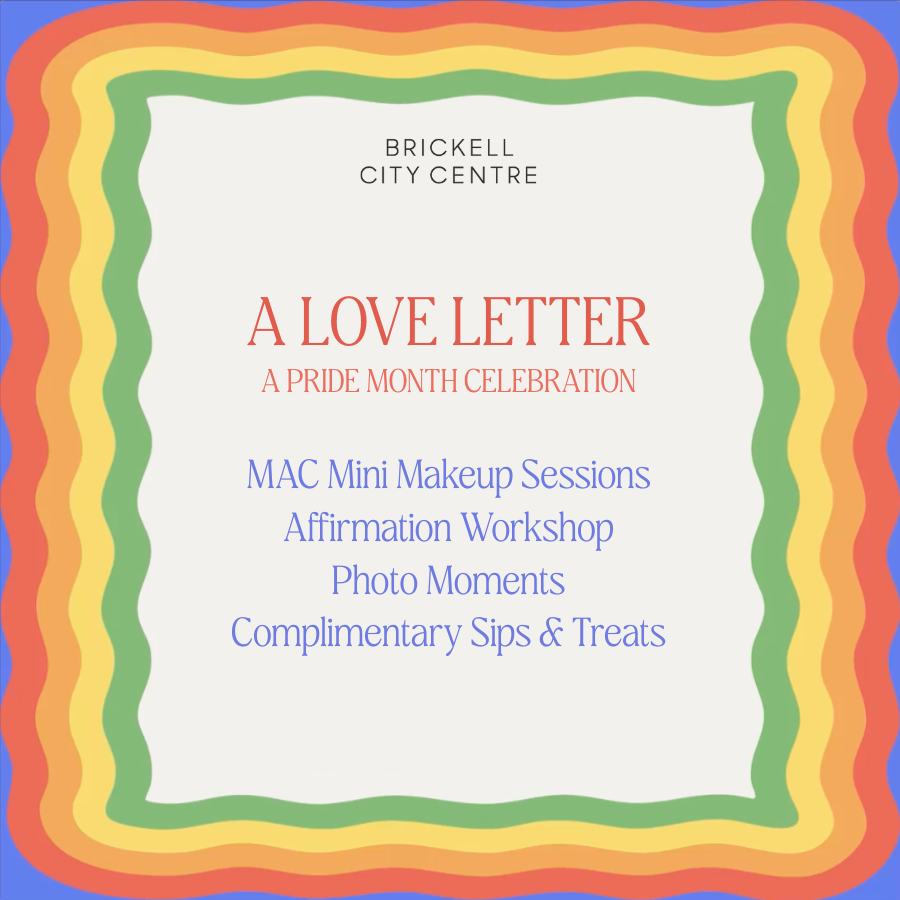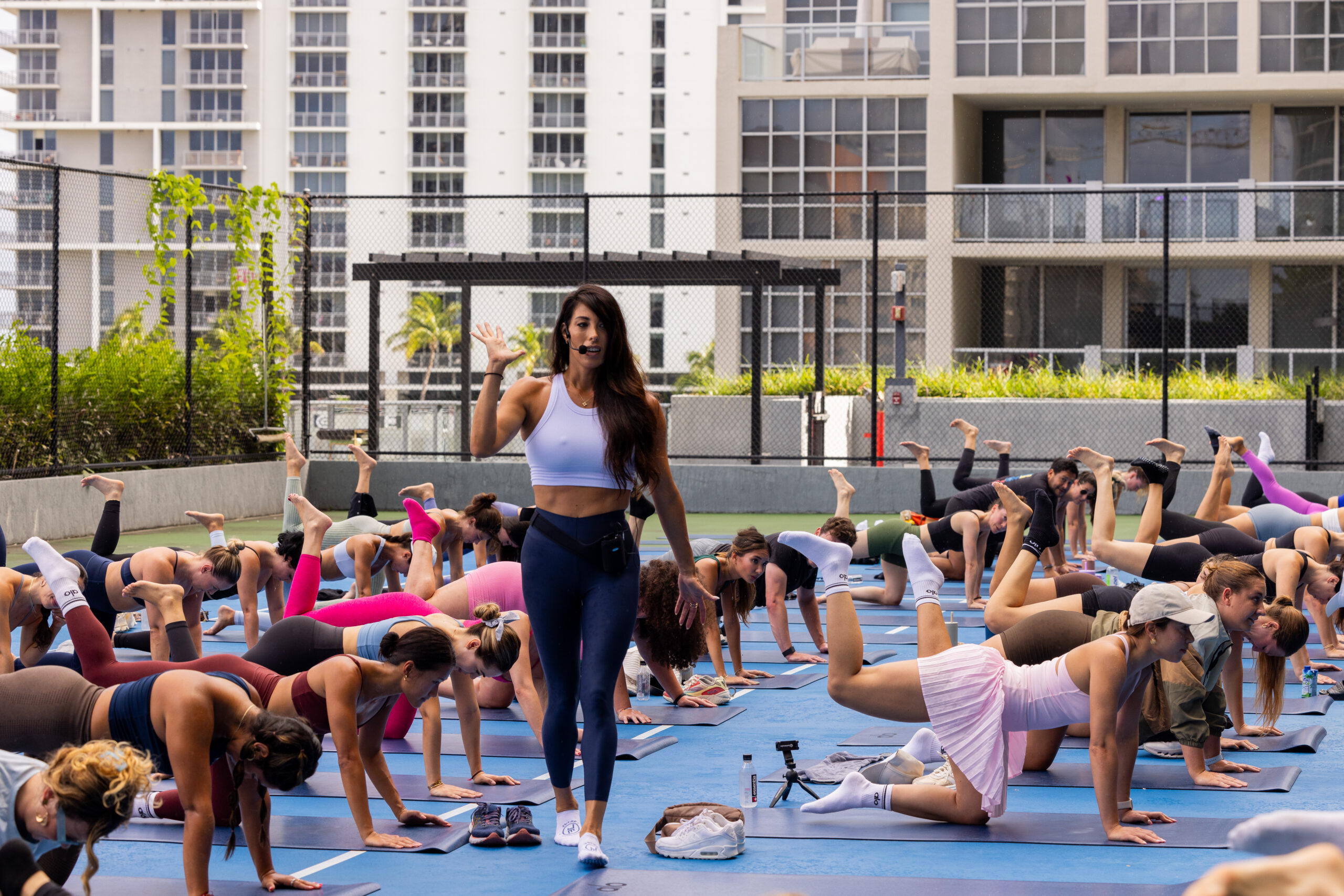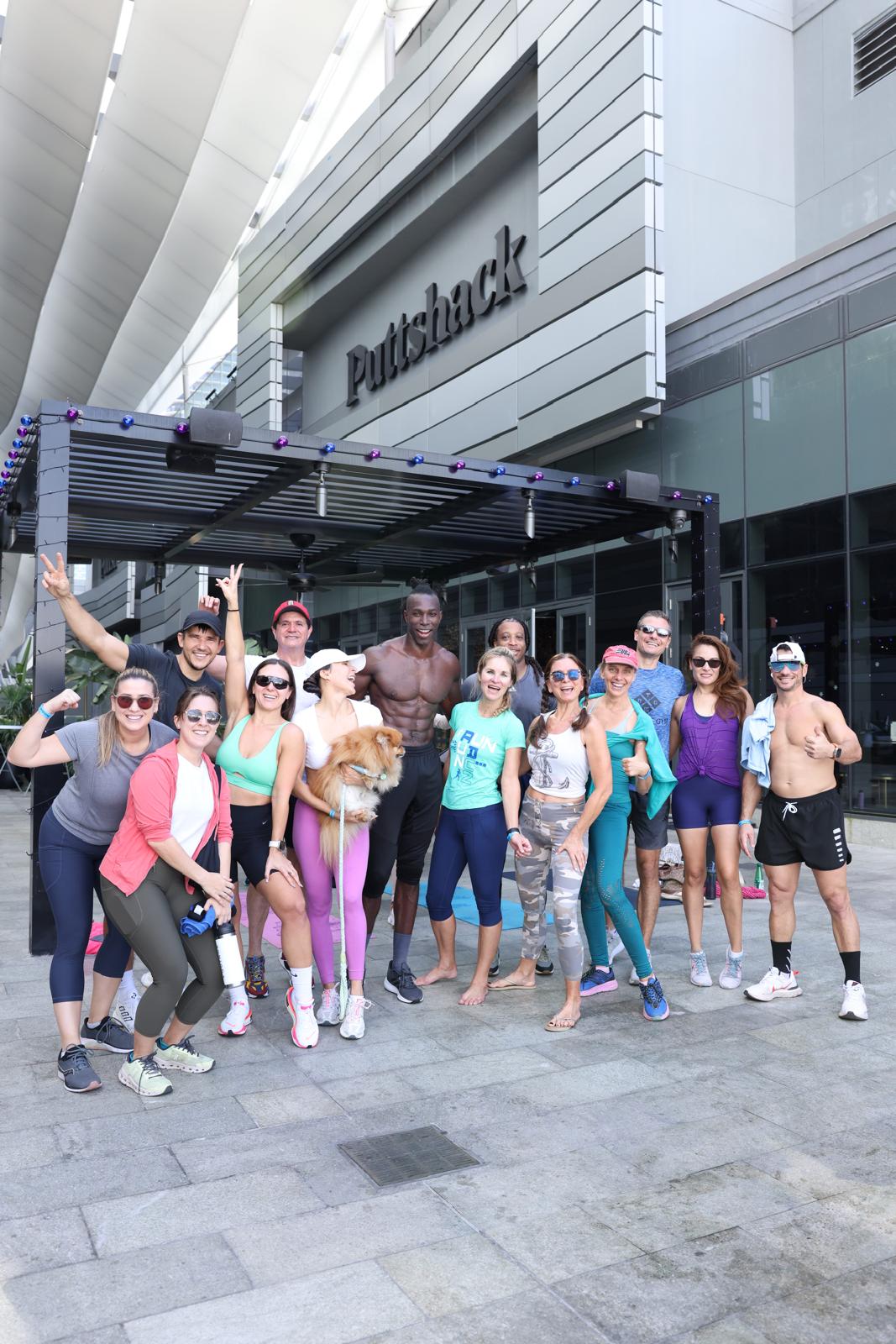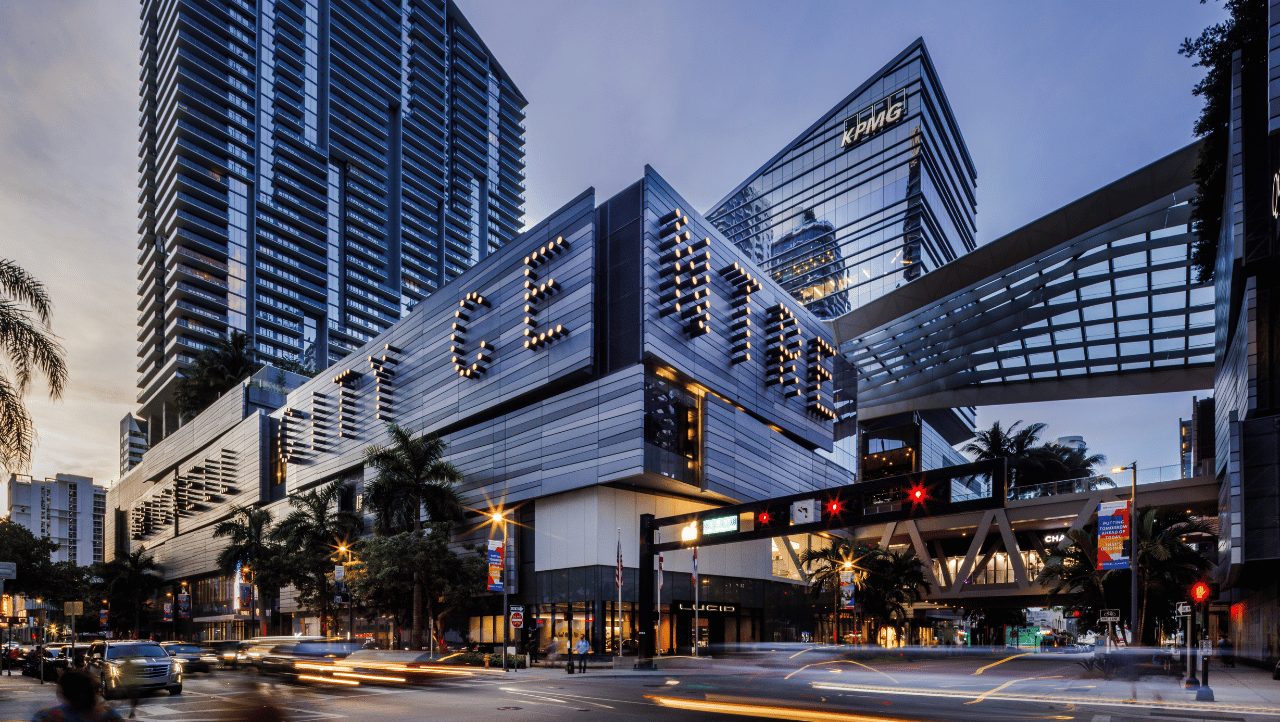Pride at BCC x MAC

Open today 11 am- 9 pm


Come walk, jog, run, and meet others in your community who are embarking on their own road to wellness. This run is open to all levels, and no matter what pace you plan to move at, someone will be there to move with you. Your Community Coach and pacers will lead you on a 2-3 mile run through Brickell that starts and finishes at Nike Well Collective – Brickell. After the run, cooldown with complimentary snacks, beverages, and your Brickell running community.


Join us for a signature Jetset Pilates class at Brickell City Centre. Connect with your body through mindful movement and enjoy a refreshing workout. All levels welcome! Please bring your own mat.

Come walk, jog, run, and meet others in your community who are embarking on their own road to wellness. This run is open to all levels, and no matter what pace you plan to move at, someone will be there to move with you. Your Community Coach and pacers will lead you on a 2-3 mile run through Brickell that starts and finishes at Nike Well Collective – Brickell. After the run, cooldown with complimentary snacks, beverages, and your Brickell running community.

How Malls Became Cool Again
Online shopping nearly killed them off. Gen Z is bringing them back.
Aaron Short | Business Insider | Jan 21, 2025
Last year, David Martin was showing a prospective tenant around Brickell City Centre, an open-air mall he helps manage in downtown Miami. The man was an executive from FP Movement, part of the bohemian clothing brand Free People, and Martin was hoping he would decide to lease a shop in the mall. Teens and young professionals have been drawn to Brickell’s palm-tree-lined backdrops and distinctive glass and steel trellis, which are featured regularly on TikTok, along with the elaborate CrazyShake milkshakes from Black Tap Craft Burgers & Beer.
Suddenly, as Martin was showing the FP guy around, a man in his early 20s strolled by.
“Oh, look, I know that guy!” the executive told Martin. “That was one of our influencers!”
The serendipitous encounter signaled the mall’s popularity with Gen Z, which was exactly what Martin needed to seal the deal. “OK, my job is done,'” he thought. “I’ll just send you the lease!”
FP Movement ended up opening a store in Brickell a few months later. But the moment was also evidence of something bigger: The American mall, against all odds, is cool again.
Twenty years after they were written off as a casualty of the online shopping boom, malls from the resorts of Arizona to the suburbs of New Jersey are bustling and vibrant. Vacancy rates are the lowest in two decades, and both visits and sales have been climbing steadily for the past three years. And while older shoppers are more likely to have written off the mall, Gen Zers and millennials are embracing them as the hip new hangout. In a 2023 survey by the International Council of Shopping Centers, 60% of Gen Zers said they visited malls just to socialize.
Luxury malls like Brickell are doing especially well with Gen Z. With their modern aesthetic, over-the-top dining options, and limited-edition events, they’ve become more than a chic place to socialize — they’re an extension of the digital lives of young shoppers. “Going to a mall used to be an errand, and now it’s a content opportunity,” says Casey Lewis, the author of “After School,” a newsletter on consumer trends. “The constant need to document one’s life on social media has put a larger importance on the aesthetic appeal of places like malls.”
But for today’s young shoppers, the mall offers more than an Instagram opportunity — it’s a place to practice some of the things that got lost during the social isolation of the pandemic. “Social media helps us refine our taste, but the mall lets us experiment with who we are IRL,” says Claire Lee, a cofounder of Selleb, an online platform that tracks Zoomer spending habits. “Beyond providing a backdrop for content, it’s where we can almost test-drive the personas we post about online.”
If the malls of old embraced sameness — you could always count on a Victoria’s Secret and a Cinnabon — today’s retail meccas want to stand out from the crowd. To succeed today, the mall has to be a destination for young shoppers, something they’ll go out of their way to experience. That’s especially true when it comes to dining. At a handful of malls on the West Coast, the star tenant is Din Tai Fung, a Taiwanese chain that’s garnered a cult following for its soup dumplings.
“Besides being delicious, it’s a very fun experience,” says Arden Yum, a college student who planned a recent visit to Orange County around a trip to the Din Tai Fung outpost at the South Coast Plaza mall. “You write down your order on the paper menu, mix your own sauce, and ask for secret menu items, like the sea salt foam with the chocolate xiao long bao that are filled with molten chocolate.”
Once the epitome of artificiality — a sanitized simulacrum of the town square — America’s malls now serve as one of the last vestiges of real-world authenticity.
Seeing the meal for the content gold it was, Yum and her friends snapped pictures of each dish before digging in. And since they were already at the mall, they did some shopping, too. While waiting for their table, Yum picked up a pair of sunglasses at Gentle Monster, a Korean optical brand.
Celebrity partnerships have also helped position malls as destinations. In 2022, when the YouTube star MrBeast announced he would be opening the first MrBeast Burger at the American Dream megamall in New Jersey, more than 10,000 fans lined up to try his smashburgers and meet their idol. Some had slept in the mall overnight.
Over two years later, the burger joint is still going strong. “Every day at 10 a.m. there’s a line to start eating burgers at this place,” says Paul Ghermezian, American Dream’s chief operating officer. “This is a place people come into the building and ask for.”
All that attention was something of a lifeline for American Dream, which had been derailed by the pandemic only a year after opening. Located 7 miles from Midtown Manhattan, the shopping and entertainment complex includes North America’s only indoor ski slope, a skating rink, a water park, and amusement park rides — not to mention some 450 retail stores. Over the past three years, aggressive targeting of young shoppers has helped it find its footing financially. American Dream says that 2024 was its busiest year yet, with an 11% increase in foot traffic. Once the epitome of artificiality — a sanitized simulacrum of the town square — America’s malls now serve as one of the last vestiges of real-world authenticity.
“The world of physical and digital are intertwined, and allowing the two to live together is key,” Ghermezian says. “If you want to feel the wind on your face as you get splashed on the wave pool, you’ll have to be there in person. And at the same time, it’s going to make some damn good content.”
From a marketing perspective, it makes sense that malls are targeting young shoppers with high-end offerings. Studies show that Gen Zers are splurging more at their age than previous generations did. The global consulting firm Bain predicts that Zoomers will be responsible for nearly a third of all luxury sales by 2030.
Scottsdale Fashion Square, a mall in suburban Arizona, saw foot traffic jump 144% after it opened five high-end restaurants, including a Nobu, and added more luxury brands for men. “We’re trying to deliver something youthful and exciting to the marketplace,” says Kim Choukalas, who manages the mall’s leasing. “The instant gratification of buying at a brick-and-mortar location will never go away.”
“Sometimes you think about old worn-down strip malls that are not very exciting places to be,” says one influencer. “But newer malls are pretty fun.”
In Miami, the Brickell mall specializes in high-end retailers, like Marc Jacobs and Luca Faloni. But over the past year, it’s also made a point of adding more accessible brands, like FP Movement. “The high-low mix is the key thing,” says Martin, the leasing manager. “You might be drawn to something at Saks. But you can always afford something at Sephora or H&M.”
Cosmetics and fragrance — another Zoomer favorite — are also a reliable draw. And while the entry-level cosmetics floor has long been a staple of department stores, today’s shopping meccas are taking it up a notch. In the fall, Nordstrom, which serves as an anchor store for many malls, launched a young-adult beauty section in six locations. Kohl’s, the top-ranked department store among Zoomers in a recent survey, has a partnership with Sephora that racked up $1.4 billion in sales in 2023 alone.
In another play to young shoppers, malls have also amped up their schedule of in-person events. Brickell hosts pop-ups with local chefs. Scottsdale Fashion Square hosts a Monday Mixer series that includes sunset yoga on a rooftop. And the Mall of America — the nation’s largest mall — has added a live-action game show.
But these days, none of the marketing ploys — the live events, the fancy restaurants, the luxury perfumes — would mean anything if they didn’t show up on social media. To grab the attention of young shoppers, Simon Property Group, the nation’s largest mall operator, has launched a campaign with local influencers to create social media posts from its shopping centers set to the soundtrack of “The Breakfast Club,” some of which have gone viral. “Sometimes you think about old worn-down strip malls that are not very exciting places to be,” says Jenny Duan, a college student in California who has partnered with Simon on influencer campaigns. “But newer malls are pretty fun.”
After the success of BeastBurger at American Dream, Ghermezian has expanded the mall’s collaborations with content creators, giving the Twitch stars Kai Cenat and Adin Ross carte blanche to film streaming videos inside the mall. “It’s a different world now,” he says. In the old days, seeing a live broadcast on TV might make you curious enough to swing by the mall to see what was going on. But today, he says, the publicity that matters most has to be produced by the very shoppers he’s trying to attract. The message to Gen Z isn’t just “come on down,” he says. It’s “come on down — and show us what you’re up to.”
Business Insider’s Discourse stories provide perspectives on the day’s most pressing issues, informed by analysis, reporting, and expertise.
Medical clinics, schools and apartments: For a decade, shopping mall owners have been desperately seeking new options for space vacated by shuttered department stores and bankrupt retailers.
One former J.C. Penney store at Westfield Garden State Plaza, a mall in Paramus, N.J., heralds yet another direction: themed attractions — or the catchier term, “retailtainment” — based on popular toy brands like Play-Doh and Nerf.
Construction workers have already divided up the second and third floors of the store into what will be the Nerf Action Xperience — Nerf AX for short — an attraction dedicated to the spongy, lightweight plaything made by Hasbro that includes mini footballs and blasters that shoot foam darts.
Brigid Witzke, head of new openings and projects at Brite Management, the site’s operator, wove around scissor lifts and dumpsters as she led a tour on a recent morning, pointing to where visitors will be able to shoot foam basketballs at moving hoops and race through a parkour-inspired obstacle course.
In a maze of rooms on the upper level, “you’re going to feel like you’re in a postapocalyptic train station,” Ms. Witzke said.
When it opens later this year, Nerf AX will join an explosion of entertainment concepts taking over an even larger share of retail spaces in an effort that started decades ago. But now, no longer just a movie theater or an arcade, these new, sprawling attractions cater to a variety of niche interests from Formula 1 racing to immersive installations for fans of Netflix shows and movies.
In the latest effort, mall owners are spending millions to entice shoppers to keep coming back. An additional 11 percent of entertainment space, or more than nine million square feet, has been planned for opening in North America by 2025, according to a 2023 report from the real estate firm JLL.
It’s all part of a broad trend that real estate experts call “experiential retail” or “retailtainment.” It’s evolved from what used to be called the “experience economy,” a term introduced in a 1998 article in The Harvard Business Review that predicted that malls would someday become more like theme parks.
That prediction was ahead of its time. With a few notable exceptions, most malls were largely unchanged until the last decade, when the shift to online shopping and later the Covid pandemic kept shoppers home. Now, mall owners are hoping the fun and games will draw people back to their properties.
Some of the new enterprises offer mall operators the opportunity to fill the yawning empty spaces left behind by department stores, a sector that continues to contract.
“We are the new anchor tenants,” said Corey Redmond, senior executive vice president of Kingsmen Xperience, the Los Angeles attraction company that created the Nerf AX site in Paramus.
Most of the activity is taking place at upscale malls — roughly a quarter of about 1,000 malls in the country, said Vince Tibone, head of U.S. retail and industrial research for the real estate analytics firm Green Street — while other malls continue to struggle. The entertainment concepts can be expensive and cost millions to build, and landlords often split the bill with operators.
A challenge, after all that spending, will be keeping people coming back to a unique entertainment venue.
“Some brands work really well one day, then they get cold,” said Matt Proulx, Hasbro’s senior vice president who leads the company’s “location-based entertainment” business — what toy companies call their real estate ventures. The company, which is based in Pawtucket, R.I., opened a Nerf AX in a mall in Manchester, England, last year, and has “Peppa Pig” theme parks in the United States and Germany and a restaurant in Hong Kong inspired by “Transformers.”
Still, Mr. Proulx said he believed attractions could stave off brand fatigue by “always innovating” and updating regularly to draw repeat customers. And they provide a new way to offer something decidedly old school: the sale of goods. At Nerf AX in Paramus, 2,400 square feet will be devoted to selling the brand’s toys and games, on the theory that a visitor might want a blaster to take home. “These retail areas are opportunities to move more product,” Mr. Proulx said.
The pandemic helped to accelerate malls moving in this direction. During the global health crisis, retailers like Bed Bath & Beyond and Brooks Brothers filed for bankruptcy, and owners and managers of retail real estate found themselves with record vacancies — but also with greater openness to filling those empty spaces with nontraditional business models, like pop-ups, immersive art installations and experiential offerings including pickleball courts and escape rooms.
For toy companies, the concepts offer new and potentially solid revenue streams: They license their intellectual property to attraction firms that take a doll or game and extrapolate a full-scale environment.
Merlin Entertainments, a theme park operator based in Britain, recently spent $5 million renovating its Lego Discovery Center in a mall in Atlanta. Now visitors can build their own rockets with the interlocking plastic bricks, scan their contraptions so they appear on an overhead screen, then launch them with a joystick. “The look and feel is updated,” said Scott O’Neil, chief executive of Merlin.
And it’s not just toy companies: Netflix took over a former Lord & Taylor at the King of Prussia mall outside Philadelphia to create immersive installations based on popular shows and movies, and attractions have been devoted to beloved series like “Friends” and “The Office,” as well as newer fare including “Only Murders in the Building” and “Squid Game.”
“These things didn’t exist prior to a handful of years ago,” said Andy Lederman, chief executive of Bucket Listers, creator of immersive experiences based on “Golden Girls” and Barbie, a Mattel brand.
Triple Five Group, a Canadian developer, pioneered retailtainment in 1992 when it opened the Mall of America in Bloomington, Minn., with an amusement park taking up 20 percent of the property’s square footage, said Paul Ghermezian, chief operations officer at Triple Five. The company’s American Dream mall in East Rutherford, N.J., has 50 percent of its square footage devoted to entertainment.
At Area15, a mall outside Las Vegas, the entire property is dedicated to entertainment concepts. At other malls, the offerings are more lightly sprinkled in with traditional retailers. Attraction firms identify areas where the demographic profile suits the entertainment concepts.
Even adults can get in on the fun: At Paramus’s Garden State Plaza — where a plan to add housing was recently approved — Pinstripes opened in a former Uniqlo space in February, offering Italian food on the main level and bowling and bocce ball below.
As for the former J.C. Penney space, the ground floor is now a Planet Playskool, another partnership between Hasbro, Kingsmen and Brite, that opened in June and is filled with activities based on brands like Play-Doh and Spirograph.
There, Jayden, age 3 ½, was building a helicopter from Tinkertoy parts. “Anything to keep him occupied,” said Song Hahn, his mother, who added that the mall location meant they could also run errands and get lunch during their outing.

MIAMI (Feb. 14, 2024) – The Shops at Brickell City Centre (BCC), Miami’s premier retail and lifestyle destination developed by Swire Properties, is continuing to expand its retail landscape with the addition of global fashion leader H&M. This exciting development marks the beginning of a series of new leases that will not only enrich and diversify the BCC experience but will also propel The Shops to achieve full occupancy (100% leased) for the first time since the Centre opened in 2016.
H&M will open in a Brickell City Centre anchor space, occupying two levels and more than 25,000 square feet. Carrying women’s, men’s, and kids’ collections, H&M Brickell will offer everything from fashion pieces and unique designer collaborations to affordable wardrobe essentials, complete-the-look accessories, and motivational workout wear. The storefront will feature upgraded finishes, including tile flooring, special tile detailing, open-air ceilings, a grand staircase, guest lounge areas, and a large-scale screen featuring H&M’s latest campaigns.
Post-pandemic, nearly 50% of Americans report having no shared space for leisure and community engagement. In response, Brickell City Centre has curated a central, walkable gathering place for locals that offers tailored retail, dining, and entertainment experiences for all. The influx of Miami transplants since 2020 has changed the demographics that define the city, and BCC has been agile in meeting the community’s needs with a selection of shops that represent and cater to them. And, as a result, in a time when many shopping destinations across the nation are facing challenges, BCC stands as a beacon of success. Impressively, The Shops at BCC has introduced 24 new brands in the four years since 2020. In a significant milestone, BCC achieved a remarkable 21.4% surge in foot traffic, coupled with a 13% year-over-year boost in retail sales throughout 2023 compared to figures from 2022. Most notably, the shopping centre achieved record visitors during 2023’s holiday season, reflecting the destination’s unprecedented growth in the four years since the pandemic and accomplishment in carefully curating its tenant mix over the same period. H&M will join top performers like Zara, Levi’s, and Chanel Fragrance and Beauty Boutique.
H&M will be on Level 2 of North Block in Suite 281C at Brickell City Centre, 701 South Miami Ave. For more information about new tenants and leasing opportunities, visit www.brickellcitycentre.com.
About Brickell City Centre
The Shops at Brickell City Centre (BCC), developed by Swire Properties, is Miami’s premier retail and lifestyle destination for dining, entertainment, shopping, and culture. The Shops serves the modern Brickell neighborhood with four levels of boutiques and nationally recognized retail brands, world-class dining, and entertainment anchored by the iconic Saks Fifth Avenue and world-class dining. The broader Brickell City Centre project is a $1 billion, 4.9 million-square-foot mixed-use development comprised of two residential towers, two mid-rise Class A office buildings, and the EAST Miami hotel above the fully leased supercharged fashion and culinary experience: The Shops
The Shops at Brickell City Centre’s Expanded Dining Roster to Include Outposts of Popular Upscale and Fast-Casual Dining Like Starbucks, Motek, The Henry and More
MIAMI (Sept. 19, 2023) – The Shops at Brickell City Centre (BCC), Miami’s neighborhood destination for dining, shopping, entertainment, and culture developed by Swire Properties, is complementing its current retail offerings with the debut of six new food and beverage tenants. The arrivals increase BCC’s total dining concepts to 18, establishing the destination as the capital of Miami’s fastest-growing neighborhood.
This summer, The Henry – Brickell’s new, greatest neighborhood restaurant – opened on BCC’s Level 1, already defining the iconic crossing of Miami Avenue and 8th Street. Allowing diners to feel the street’s vibrancy, visitors are drawn to the all-day activity of the restaurant, which offers breakfast, lunch, dinner, and cocktails. From multi-James Beard award-nominated restaurateur Sam Fox, The Henry offers a fusion of industrial and classical influences in this open dining space that bursts with charm and energy. Passersby can also grab a quick smoothie, breakfast, or signature coffee through their Coffee Window or Ventanita to enjoy while they shop.
Continuing the momentum, Café Americano now operates as BCC’s contemporary, Latin-inspired diner. With a bright and sophisticated design, the café offers innovative dishes and a bold mix of breakfast, lunch, and dinner dishes that tempt even the most refined palates.
South Florida’s beloved Israeli Mediterranean destination, Motek, joins BCC as a testament to the neighborhood’s appeal to new business. Elevating BCC’s portfolio of cuisine with genuine and fresh Mediterranean-inspired dishes, this kosher-style bistro will have a transportive Levant interior, an iconic bar alongside an all-new beverage program, and the brand’s first-ever in-house bakery to complement its cuisine influenced by flavors from Israel, the Middle East and the Eastern Mediterranean.
Everyone’s favorite fast-casual coffee shop, Starbucks, debuted last month on Level 3. Conceptualized by Starbucks headquarters’ design team, this location features a unique carved wood façade to create a sophisticated yet cozy ambiance. Guests are welcome to sip the best brews and blends while browsing The Shops or sit for breakfast and conversation.
Miami’s Miu’s Tea will expand to Brickell this fall with a new location at BCC. Serving the bubble teas, Miu’s Tea will offer their famed Milk Teas, Iced Tea Lattes, matches, and fruity beverages to cool down shoppers from the Miami heat.
And come 2024, Black Tap Craft Burgers & Beer will join BCC, opening their first Florida location and serving award-winning bites, indulgent milkshakes, and refreshing brews. Inspired by old-school NYC luncheonettes, Black Tap is a fresh and upscale take on the classic burger joint.
“Brickell City Centre has welcomed more and more visitors each year, with an almost 10% increase in foot traffic year-to-date in 2023 over 2022,” said Martin. “Our strategy to diversify The Shops through retail, dining, and entertainment concepts for all has been immensely successful, and introducing these new restaurants will surely continue the momentum and our role as a vibrant hub in the heart of Brickell.”
Brickell City Centre is located at 701 South Miami Ave. For more information and to learn about leasing opportunities, visit www.brickellcitycentre.com.
About Brickell City Centre
The Shops at Brickell City Centre (BCC) is Miami’s neighborhood destination for dining, entertainment, shopping, and culture developed by Swire Properties. With four levels of boutiques, world-class dining, and nationally recognized brands, The Shops at BCC has something for every shopper to enjoy and serves Miami’s modern neighborhood. In the past few months, The Shops welcomed Puttshack, Blue Nile, Jo Malone London, Warby Parker, Sugarfina, Sunglass Hut, ZADIG & VOLTAIRE, Rhone, and SISU Spa to its robust roster of tenants. The community centre is also home to various crowd favorites, including Nike, Zara, Lululemon, Sephora, CMX Cinemas, and the iconic Saks Fifth Avenue. The project is a $1 billion, 4.9 million-square-foot mixed-use development comprised of two residential towers, two mid-rise Class A office buildings, and the EAST Miami hotel above a supercharged fashion and culinary experience – The Shops.